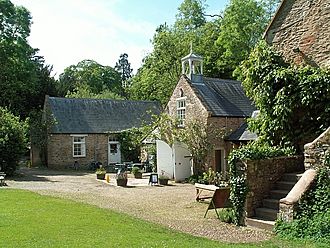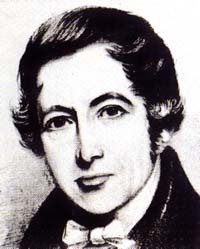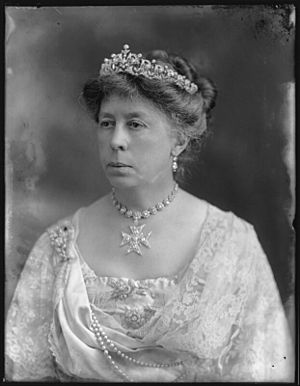Fyne Court facts for kids
Quick facts for kids Fyne Court |
|
|---|---|

The cafe and shop at Fyne Court
|
|
| General information | |
| Town or city | Broomfield |
| Country | England |
| Coordinates | 51°04′50″N 3°06′52″W / 51.080563°N 3.114310°W |
| Client | Andrew Crosse |
Fyne Court is a special place in Broomfield, Somerset, England. It's a nature reserve and visitor centre owned by the National Trust. It used to be a big country house that belonged to the Crosse family for many years. We don't know exactly when it was built.
In the early 1800s, a scientist named Andrew Crosse lived here. He did many exciting experiments with electricity, even building huge electric batteries called voltaic piles. The main house sadly burned down in 1894. But some parts of the building survived. These parts are now used as offices and a visitor centre by groups like the Somerset Wildlife Trust and the Quantock Hills AONB Service. The National Trust took over Fyne Court in 1967. The area around the house is a large estate with woodlands, ponds, and meadows. You can also find a folly (a decorative building) and a boathouse on the grounds.
The Story of Fyne Court
Fyne Court is built on land that was once the beautiful gardens of a large house. This house belonged to Andrew Crosse, a famous scientist from the 1800s. His family had owned the house since it was first built.
Andrew Crosse became in charge of his family's land when he was 21. This was after his parents passed away in the early 1800s. He loved to experiment with electricity. One of his most amazing projects was a huge setup to study electricity in the air. He used a long wire, over a mile long at first, stretched between poles and trees! With this wire, he could figure out how the air's electricity changed in different weather. His friend, George Singer, wrote about Andrew's findings in a book in 1814.
Andrew Crosse was one of the first people to build large voltaic piles, which are like early batteries. He worked with another famous scientist, Humphry Davy, who even visited Fyne Court in 1827. Andrew built many batteries. One of them had 50 jars and a huge surface area for collecting electricity. He could charge and discharge it many times a minute. When it discharged, it made a noise almost as loud as a cannon! Because of his experiments, people in the area called him "the thunder and lightning man." In 1836, another visitor saw 2,500 of Andrew's batteries at Fyne Court!
Fyne Court was also the childhood home of Susan Harris, who later became the Countess of Malmesbury. Her father was John Hamilton of Fyne Court. She was the second wife of James Harris, 3rd Earl of Malmesbury, who was a politician. Susan wrote books and articles, including one called 'Village Life in England'. In it, she shared memories of growing up in Broomfield.
Sadly, the main house at Fyne Court burned down in 1894. But the separate music room, where Andrew Crosse did many of his experiments, survived. Some of his books and paintings by famous artists like Anthony van Dyck and Peter Paul Rubens were also saved. You can still see the table where Andrew Crosse did his experiments in the Church of St. Mary and All Saints in Broomfield. There's also a tall stone monument, called an obelisk, in the churchyard to remember him.
In 1918, a large part of the woodland at Fyne Court was sold. Later, in 1967, John Adams left Fyne Court to the National Trust. It officially became theirs in 1972 after some legal matters were sorted out. For a while, it was also the main office for the Somerset Wildlife Trust. Today, the Quantock Hills AONB Service also has its headquarters on the grounds.
Exploring the Grounds
Fyne Court is surrounded by a large estate that covers about 65 acres. Much of the original garden design, including a tree garden planted in 1780, has grown wild over time. This creates many different natural areas, like woodlands with broadleaf trees, ponds, and meadows where Highland cattle graze.
The site is home to over 100 types of fungi and some rare insects. In the grounds, you can find a folly, which is a decorative building with two towers that have a special top edge called crenelated. There's also a boathouse by one of the ponds.




